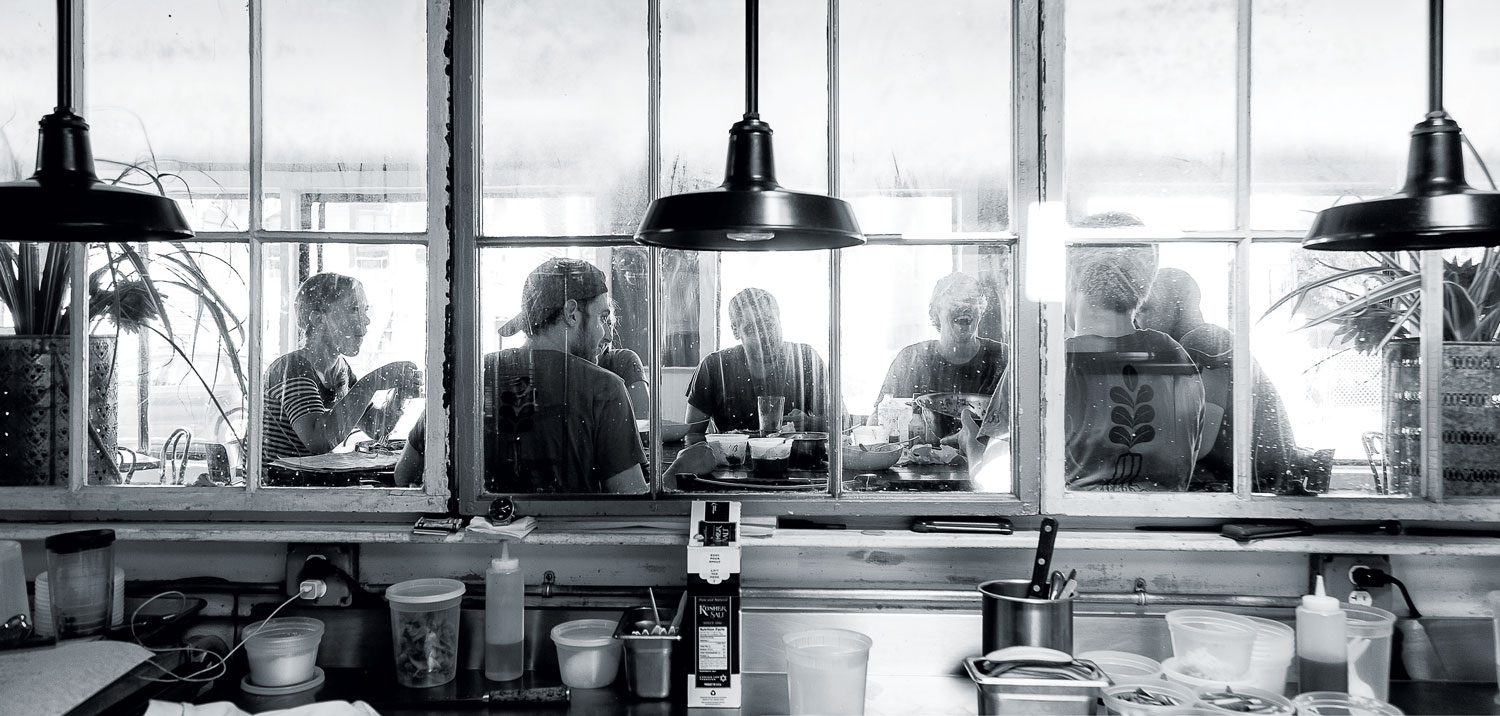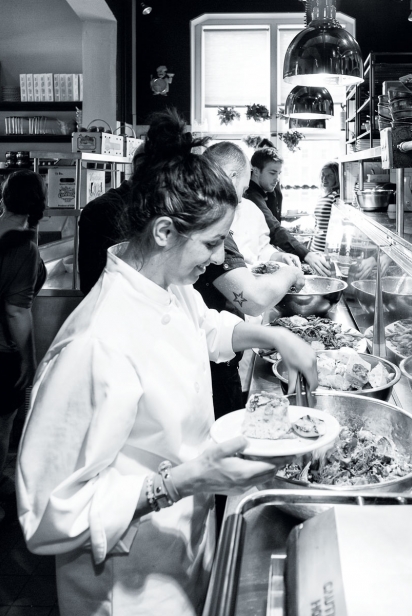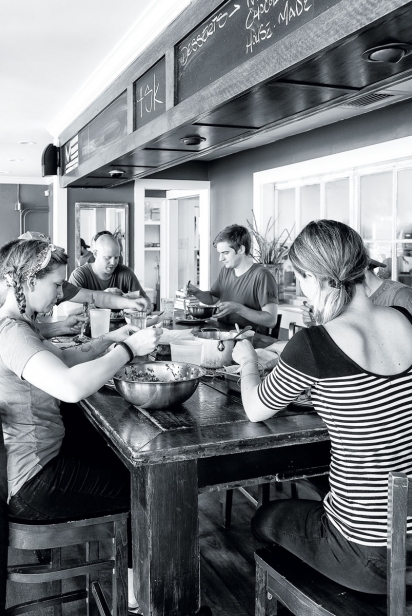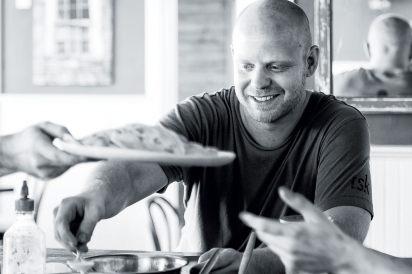Staff Meals: Kitchen Crews Gather For Their Own Meal Before Doors Open
It’s 2:30 on a steamy summer afternoon at Thames Street Kitchen in Newport, and Steve Yerger, a line cook, has no idea what he’ll prepare for the daily 4 pm staff meal, to take place in just a little over an hour.
“I’ll ask the four other cooks, ‘Who has what?’ in the way of leftovers, and we’ll take it from there,” he says. Leftovers might mean fish scraps from the previous evening’s black sea bass special, or unused chicken wings, or basic potatoes, carrots and onions. It’s a testament to the cooks’ imagination and ability to think on their feet that they will transform these random ingredients into a quick, wholesome and inexpensive meal that will keep them going through a busy night of service.
Recent staff meals at TSK, as it’s familiarly called, have included fried chicken with mashed potatoes, short ribs with pasta, fried green tomato sandwiches, chicken salad sandwiches and a variety of tacos.
“Sometimes we’ll even just get burgers and dogs from our sister restaurant, Mission [a popular burger joint],” he says.
“Dessert?” I ask.
“Not really, but maybe we should start doing it.”
Welcome to the crazy world of the restaurant kitchen, where in hot, tight quarters, amid a cacophony of clanging pots and pans and relentless pressure to get the customers’ meals out efficiently, deliciously and beautifully, the workers function as a team, standing on their feet for hours at a stretch. Everybody from the dishwasher to the wait staff has his or her job, and this kind of collaboration forms strong bonds. Eating together makes them even stronger.
“Staff meal really is like a traditional family meal,” says Yerger. “We eat together at the 10-seat communal table in the dining room. Sometimes we talk about work, sometimes about TV, or anything else. It might last 15, 20 or 30 minutes, depending on how busy we are.”
Julia Hoffer, who with her twin sister, Anna Jenkins, and their husbands, Chad Hoffer and Tyler Burnley, owns TSK, echoes Yerger’s sentiments.
“Staff meal is a very big deal here,” she says. “It’s a huge boost to everyone’s morale. When you’re standing from 10 am till late at night, you’re really appreciative of having had a good meal.”
Indeed, “family meal” is synonymous with staff meal in many establishments. A number of cookbooks including Staff Meals from Chanterelle, by David Waltuck, and Family Table: Favorite Staff Meals from Our Restaurants to Your Home, by Michael Romano, Karen Stabiner and Danny Meyer, attest to the compelling nature of the repast.
The exact origins of staff meals in restaurants are unclear, although it is widely believed that they began in Europe, possibly in Hadrian’s Italy. It is universally agreed that their purpose was—and is—to fuel workers during their shifts.
Staff meals take many different forms. Hotels often operate staff dining rooms, where employees get their meals, while chain restaurants might provide employee discounts or credits for food. Staff meals may take place pre- or post-service. They are a mainstay at the Culinary Arts program at Johnson & Wales University (JWU) in Providence, where they exist in several variations.
“In some classes, the students prepare meals and set the tables in the dining room to make it a very civilized affair,” says George O’Palenick, a retired associate professor in the Culinary Arts program. Other times, the kitchen staff feeds the dining room staff before feeding themselves. Whether it’s a technique-oriented lab, where students perfect a particular dish, or a nutrition class, students are always encouraged to taste each other’s food.
“In the big picture, the restaurant business is a tough scenario. Staff meals help camaraderie,” he adds.
Peter Lehmuller, dean of the College of Culinary Arts at JWU, agrees: “It makes sense when people are working long hours that they are well fed. From a management viewpoint, restaurants that feed their workers properly earn loyalty from their employees. Staff meals are reflective of the institution; the way they treat their staffs often reflects the way they treat their customers.”
How do staff meals relate to what’s on the restaurant’s menu?
At La Masseria in East Greenwich, the staff, which can include up to 20 workers, chooses a menu item as a group and the chef in charge prepares it for them at 3:30 pm each day.
“It might be pasta or chicken or a special of the day,” says the manager Andrea Minopoli. Employees also receive a 50% discount off the menu price.
This option is available to the large crew of wait staff at Bacaro in Providence, too, and has proven very popular, according to chef/owner Brian Kingsford. In addition to the daily staff meal, the staff is encouraged to purchase meals or wine at the discount, after their shift, for educational purposes.
But the main emphasis for staff meal, Kingsford notes, is “to teach young aspiring cooks to think like a chef.” This means “harvesting” leftover items from the various stations, identifying what to do with them, and using them as the inspiration for the meal.
“Of course, what they have harvested will never equate to the whole meal but it sets the tone as to whether they are going to make pasta, rice, chicken, tortillas, etc.”
Preparation of the staff meal rotates among 14 line cooks. It is served family-style and might range in ethnicity from Italian to Korean.
“It is not bound by the identity of the restaurant,” says Kingsford.
“The cooks are cooking for some pretty discerning palates: the rest of their peers as well as the wait staff, who will have no problem calling out a cook on a less-well-thought-out staff meal. The kitchen crew themselves have to compete amongst each other to show that they are worthy of wearing their whites, so the last thing one wants to do is disappoint,” he says.
The more experienced staff members set the pace by thinking ahead to their turn at preparing staff meal. They might prepare a condiment or dish in advance of the meal, using various ingredients they have collected, and then serve it forth when they deem it worthy. Sous-chef Alan Bagley, for example, made a jar of kimchi, a pungent Korean fermented vegetable dish that requires a month or so of marination, with scraps of cabbage he had gleaned, and then quietly produced it from his cooler when it was his turn to produce a meal. This type of creativity and resourcefulness is inspiring for young cooks, Kingsford says.
“As far as morale, staff meal is comparable to the 5 o’clock dinner table growing up,” Kingsford adds. “It is the place where the staff [family] communicate collectively before their shift. It is the place where things get figured out.”
Some chefs use post-service staff meals as a way to decompress. Every night between 10 and 10:45 pm, after the last customer orders are sent out to the dining room, the kitchen crew—five line cooks and two dishwashers—at Avenue N in Rumford prepare a meal on the fly and sit in the kitchen on milk crates to eat, notes chef Nick Rabar. The wait staff doesn’t partake because of space limitations; they order what they want from the menu and eat when they have a spare moment. They’re also given a pre-service meal of the evening’s specials.
It’s a very spontaneous event, which makes for some interesting experimental dishes, according to Rabar.
“One night, we made a pizza that combined cauliflower, Brussels sprouts, bacon, gorgonzola and béchamel sauce. We manifested this crazy combination, and then it made its way onto the menu.”
He describes staff meal as a kind of ritual or brotherhood essential to restaurant work.
“This is our time for taking a deep breath after we’ve just served 300 people. It comes out of necessity after having been on your feet all day long. Some places turn up the music, chew, mop up and have a drink—and then have another for the night ahead. It’s our way of being human.”
In the end, whether it takes place pre- or post-service, you can’t separate staff meal from restaurant life. As Brian Kingsford puts it, “It is the calm before the storm. It is the point at which we are all reminded by one another that we are a team, a family and in it together. We couldn’t think of a more important point in the evening.”








